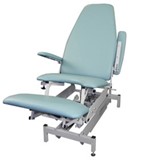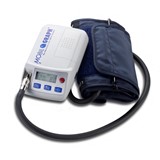UniSA researcher Dr Paul Anderson has just secured almost $607,000 to explore the links between vitamin D synthesis within bone cells, vitamin D status and bone fractures.
As lead researcher on the project Dr Anderson says the new knowledge that vitamin D is produced in many different tissues across the body is leading to exciting discoveries about the novel roles of vitamin D in reducing the incidence of a variety of diseases.
"We have long understood that the process of vitamin D formation in the body begins with some exposure of the skin to sunlight and it was believed that only the kidneys completed the manufacture of vitamin D," Dr Anderson says.
"We now believe that while vitamin D supplied by the kidneys is important to maintain calcium balance, vitamin D production and activity in the bone cells themselves may have a very significant role to play in maintaining bone density."
Dr Anderson says that his research may provide an explanation for the need to maintain adequate vitamin D levels throughout life to reduce bone deterioration and prevent osteoporosis which is something that we need to consider much earlier in life, before it is too late.
Of particular interest to Dr Anderson and his team is the key enzyme known as CYP27B1 or 1-hydroxylase and its role in activating vitamin D in the bone forming cells.
"Understanding more about how and why vitamin D is manufactured in bone cells will provide invaluable information that will inform us about our broader interests in vitamin D production in other tissues and its role in disease prevention," he says.
"In this project we are looking at vitamin D in bone formation but it is also important to understand the role of vitamin D in other bone cells that break down bone which is part of wider program of research we are working on.
"Our current research findings have ramifications for us all. Up to 60 per cent of us in Australia do not have enough vitamin D to ensure our skeleton remains as strong as it should be. Osteoporosis affects over two million Australians and that is only going to increase as our society ages. The link between low levels of vitamin D and osteoporosis is quite clear and so we need to start thinking about treating low vitamin D levels earlier in life to limit the amount of bone we lose through life. The more bone you keep early in life, the less likely it is you will get osteoporosis later on."
And it is also emerging that there may be other reasons to improve our vitamin D level with associations between vitamin D deficiency and the incidence of other illnesses such as some cancers, Multiple Sclerosis and other auto immune diseases."
But Dr Anderson says there is confusion about how much sunlight exposure is enough to maintain the body’s production of vitamin D which does not increase the risk of skin cancer.
"Exposing some part of the body to sunlight for short periods of time each day is needed to produce enough vitamin D which ideally can be done before 10am or after 4 pm during summer so as to not to be harmful to the skin. For many this is actually difficult to do, especially during the working week and so, if this sun exposure is not possible, then taking a vitamin D supplement should be recommended," he says.
"Ultimately, the more we know about the role of vitamin D, how and where it is produced in the body and what actions it performs, the better our understanding will be about how much vitamin D we need to help stay healthy," he says.
"In the meantime our research will focus on understanding the production of vitamin D in bone-forming cell development and how that supports better bone health in the young so that they have better bone health when they get older."
Dr Anderson’s research was one of eight to win funding in the 2012 NHMRC grants round.
UniSA researchers secured almost $4million for five key health research projects along with a Career Development Fellowship, an Early Career Fellowship, and a Translating Research into Practice (TRIP) Fellowship.
UniSA Vice Chancellor Professor Peter Høj said he was delighted to see recognition of UniSA’s world class health research.
"South Australian universities performed very well in this year’s round of highly competitive NHMRC funding grants and there are strong collaborations and links in the state that run across the universities, and other research facilities including research hospitals and centres," Prof Høj said.
"UniSA is continuing to expand its health research base and is leading and contributing to important projects such as the work Dr Anderson and his team are undertaking into vitamin D.
"Our aim is to continue to encourage and support the kind of research that will make a difference to the health and well being of all Australians."
- Suppliers
- New to MedicalSearch? Book a Demo
- Advertise with us
- Login
- Email Marketing
- Buyers
- Get Quotes
- Articles & Ideas
- Login
- Subscribe to newsletter
- My Details
- Get Quotes
- Accident & Emergency Care
- Aged Care & Disability
- Anaesthesia & Respiratory Care
- Beauty & Wellness
- Cardiology & Cardiac Surgery
- Commercial Cleaning & Laundry Supplies
- Dental Care & Oral Surgery
- Diagnostic Instruments & Medical Imaging
- Disinfection & Sterilisation
- ENT & Audiology
- Gynaecology & Obstetrics
- Homecare & Consumer Medical
- Hospital Equipment & Supplies
- Intensive Care Unit
- Laboratory & Pathology
- Medical Apparel
- Medical Devices & Products
- Medical Fridges & Freezers
- Medical Storage & Filing
- Medical Waste Management
- Optometry & Ophthalmology
- Orthopaedics & Podiatry
- Paediatrics & Neonatology
- Patient Monitoring & Management
- Physiotherapy & Rehabilitation
- PPE & Infection Control
- Single Use Medical Consumables
- Surgical Tools & Supplies
- Treatment Beds, Tables & Couches
- Veterinary Equipment
- Wheelchairs & Mobility Aids
- Get Quotes
- Accident & Emergency Care
- Aged Care & Disability
- Anaesthesia & Respiratory Care
- Beauty & Wellness
- Cardiology & Cardiac Surgery
- Commercial Cleaning & Laundry Supplies
- Dental Care & Oral Surgery
- Diagnostic Instruments & Medical Imaging
- Disinfection & Sterilisation
- ENT & Audiology
- Gynaecology & Obstetrics
- Homecare & Consumer Medical
- Hospital Equipment & Supplies
- Intensive Care Unit
- Laboratory & Pathology
- Medical Apparel
- Medical Devices & Products
- Medical Fridges & Freezers
- Medical Storage & Filing
- Medical Waste Management
- Optometry & Ophthalmology
- Orthopaedics & Podiatry
- Paediatrics & Neonatology
- Patient Monitoring & Management
- Physiotherapy & Rehabilitation
- PPE & Infection Control
- Single Use Medical Consumables
- Surgical Tools & Supplies
- Treatment Beds, Tables & Couches
- Veterinary Equipment
- Wheelchairs & Mobility Aids
Trusted by 520,000 Australian medical buyers
Buyers
- Discover products & solutions
- Login
- Subscribe To Newsletter
- Browse All Products
- Read Articles
Suppliers
Advertise
- Promote your products & solutions
- New to MedicalSearch? Book a Demo
- Login / Forgot Password
- Advertise Your Products
- Success Stories
- Email Marketing
- Suppliers
- Advertise with us
- Login
- Email Marketing
- Buyers
- Get Quotes
- Articles & Ideas
- Login
- Subscribe to newsletter
- My Details
Get Quotes
- Accident & Emergency Care
- Aged Care & Disability
- Anaesthesia & Respiratory Care
- Beauty & Wellness
- Cardiology & Cardiac Surgery
- Commercial Cleaning & Laundry Supplies
- Dental Care & Oral Surgery
- Diagnostic Instruments & Medical Imaging
- Disinfection & Sterilisation
- ENT & Audiology
- Gynaecology & Obstetrics
- Homecare & Consumer Medical
- Hospital Equipment & Supplies
- Intensive Care Unit
- Laboratory & Pathology
- Medical Apparel
- Medical Devices & Products
- Medical Fridges & Freezers
- Medical Storage & Filing
- Medical Waste Management
- Optometry & Ophthalmology
- Orthopaedics & Podiatry
- Paediatrics & Neonatology
- Patient Monitoring & Management
- Physiotherapy & Rehabilitation
- PPE & Infection Control
- Single Use Medical Consumables
- Surgical Tools & Supplies
- Treatment Beds, Tables & Couches
- Veterinary Equipment
- Wheelchairs & Mobility Aids
Get Quotes
- Accident & Emergency Care
- Aged Care & Disability
- Anaesthesia & Respiratory Care
- Beauty & Wellness
- Cardiology & Cardiac Surgery
- Commercial Cleaning & Laundry Supplies
- Dental Care & Oral Surgery
- Diagnostic Instruments & Medical Imaging
- Disinfection & Sterilisation
- ENT & Audiology
- Gynaecology & Obstetrics
- Homecare & Consumer Medical
- Hospital Equipment & Supplies
- Intensive Care Unit
- Laboratory & Pathology
- Medical Apparel
- Medical Devices & Products
- Medical Fridges & Freezers
- Medical Storage & Filing
- Medical Waste Management
- Optometry & Ophthalmology
- Orthopaedics & Podiatry
- Paediatrics & Neonatology
- Patient Monitoring & Management
- Physiotherapy & Rehabilitation
- PPE & Infection Control
- Single Use Medical Consumables
- Surgical Tools & Supplies
- Treatment Beds, Tables & Couches
- Veterinary Equipment
- Wheelchairs & Mobility Aids
Trusted by 520,000 Australian medical buyers







